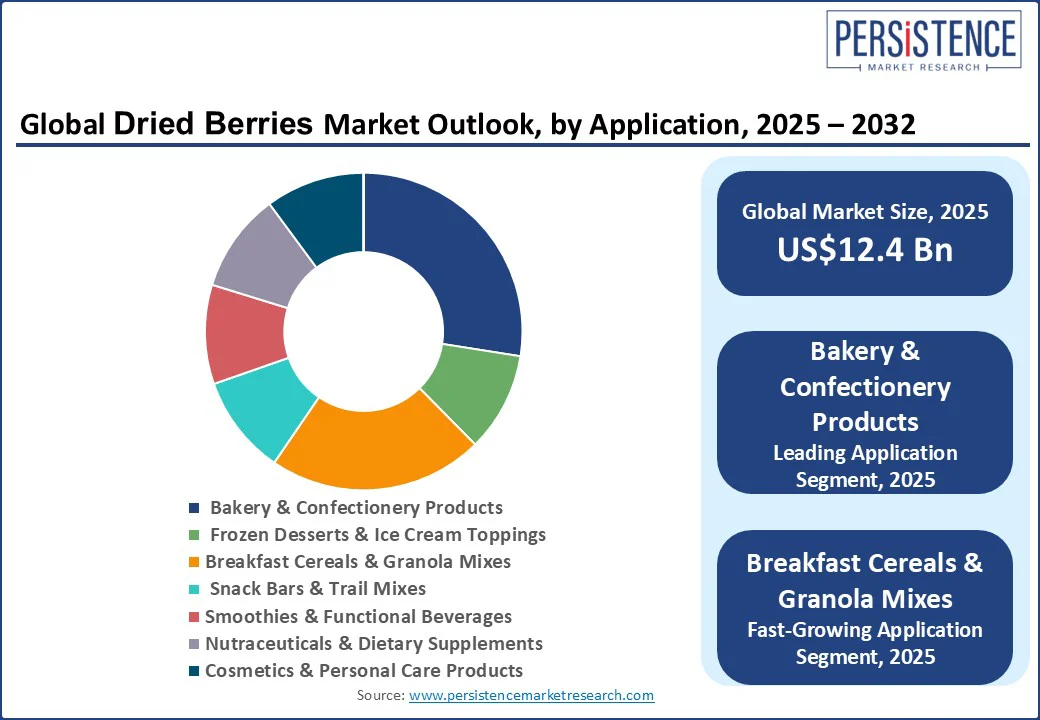ID: PMRREP35563| 196 Pages | 12 Aug 2025 | Format: PDF, Excel, PPT* | Food and Beverages

The global dried berries market size is likely to be valued at approximately US$ 12.4 Bn in 2025 and is expected to reach around US$ 21.7 Bn by 2032, growing at a CAGR of approximately 8.3% during the forecast period from 2025 to 2032. The dried berries market growth is driven by rising consumer demand for nutrient-rich, convenient snacking options and the increasing popularity of functional foods. Dried berries are widely used in breakfast cereals, trail mixes, bakery products, and health supplements. Their rich antioxidant profile and extended shelf life make them a preferred choice among health-conscious consumers and food manufacturers alike.
The growth is further driven by clean-label trends, growing interest in organic and non-GMO products, and the expansion of e-commerce platforms that offer easy access to premium dried berry varieties. Innovations in packaging and value-added formats, such as yogurt-coated and powdered berries, are also boosting the market. Rising awareness of the health benefits associated with berry consumption continues to create new opportunities in the global functional food ingredients market and the plant-based snacking market.

Key Industry Highlights:
|
Market Attribute |
Key Insights |
|
Dried Berries Market Size (2025E) |
US$ 12.4 Bn |
|
Market Value Forecast (2032F) |
US$ 21.7 Bn |
|
Projected Growth (CAGR 2025 to 2032) |
8.3% |
|
Historical Market Growth (CAGR 2019 to 2024) |
8.1% |
Consumers are increasingly seeking freeze-dried berry snacks for their high antioxidant retention and convenient portability for on-the-go lifestyles. In response, brands are introducing organic, non-GMO dried strawberries and blueberries to meet rising demand in premium health-food segments. Companies, such as Flyberry Gourmet, Namo Organics, and Rostaa, cater specifically to premium health-conscious consumers.
Manufacturers are adopting vacuum packaging methods with extended shelf life to preserve flavor and nutrients while reducing spoilage losses, supporting global distribution. Companies are investing in freeze-drying technologies to preserve anthocyanins and vitamin C with minimal nutrient loss, and to minimize their carbon footprint and position themselves in eco-certified supply chains. Hazel Technologies’ Breatheway, modified atmosphere packaging (MAP) system is used by major berry growers to regulate oxygen inside packs, significantly reducing spoilage and maintaining quality.
Food processors integrate dried berry inclusions into functional breakfast cereals and plant-based protein bars to tap the superfood trend and enhance nutritional profiles, and to attract health-driven consumers. Innovators are also launching berry-infused nutrition bars and cereal bars using novel blends such as goji-blueberry-cranberry combinations. For example, Cascadian Farm Mixed Berry Cereal combines powdered dried berries (blueberry, cranberry) with whole-grain flakes in a lightly sweetened, no-added-sugar formula, and has been recognized for its clean-label and fiber-rich profile.
The rise of e-commerce specialty dried berry stores has enabled direct access to exotic and organic varieties. Brands are also launching single-serve resealable packets of organic mixed berry snacks tailored for grab-and-go convenience.
Producers face raw material price volatility for organic blueberries due to unpredictable weather and limited seasonal supply in key regions. They struggle with quality degradation during prolonged cold storage, especially without advanced humidity control. Small-scale growers lack access to automated optical sorting systems, resulting in high defect rates and wasted produce. These issues intensify when sourcing premium certified non-GMO dried cranberries, impacting consistency and brand reputation.
Manufacturers endure limitations in handling and storage infrastructure for freeze-dried berry powder, where moisture control is critical. They face supply chain delays for organic goji berry raw materials, extending lead times and increasing costs. Competition from alternative superfood snacks and lower-priced conventional dried fruit limits the pricing power. Market fragmentation among regional dried berries producers further reduces economies of scale and weakens market positioning.
Opportunities such as food brands exploring the growing use of dried berry and including them for functional breakfast cereals to deliver antioxidant-rich nutrition. They can launch freeze-dried blueberry powder blends for smoothie and superfood bar formulations, meeting demand for convenience and clean-label ingredients. Manufacturers may innovate with berry-infused yogurt toppings and granola mix-ins to target health-conscious consumers. Exporters can benefit from premium organic goji berry snacks as exotic superfood inclusions in niche plant-based snacking lines.
Artemis is supplying branded berry powders such as Blue D’Or wild blueberry and Cran d’Or cranberry, which appear in numerous clean-label supplements and functional food formulations. Its BerryDefense blend, a standardized mix of high-anthocyanin berries, is integrated into cardiovascular and immune-support nutraceutical SKUs by supplement manufacturers looking for premium antioxidant content.
E-commerce platforms unlock new access via online specialty dried berries marketplaces, offering exotic varieties and curated berry assortments to global consumers. Co-packers can introduce single-serve resealable packets of mixed organic berries for on-the-go retail and subscription boxes.
Among all available options, dried blueberries dominate with a market share of 31.8% in 2025, emerging as both the largest and fastest-growing product segment. Their widespread usage across health foods, snacks, and premium foodservice applications has positioned them as a category leader. Blueberries are favored for their rich antioxidant profile, low-sugar content, and consumer perception as a ‘superfruit.’ They are extensively used in cereals, trail mixes, bakery products, and even powdered supplements.
The growing demand for clean-label, organic, and non-GMO varieties, especially in North America, Western Europe, and Japan, continues to fuel this segment. Advancements in freeze-drying and dehydration technologies have enhanced product stability and shelf life, making them more appealing for manufacturers targeting functional food markets.
Bakery and confectionery applications are anticipated to capture the largest market share of 32.6% in 2025, due to the widespread use of raisins, blueberries, and strawberries in muffins, cookies, breads, and chocolate-based products across global markets. These ingredients not only enhance taste and texture but also offer visual appeal and nutritional value, factors highly valued by bakery brands and consumers alike.
Conversely, cereals and snack bars represent the fastest-growing application segment, driven by the global shift toward health-conscious eating and convenience. Consumers are increasingly seeking high-fiber, antioxidant-rich breakfast solutions and portable, functional snacks. Dried berries, particularly blueberries and strawberries, are now a standard inclusion in granola clusters, oat bars, trail mixes, and protein-rich cereal products. This trend is especially strong in urban markets where demand for nutrient-dense, plant-based, and allergen-free snacks is accelerating innovation in the category.

North America continues to dominate with a market share of 41.3%, supported by high per capita consumption of packaged health foods and strong retail infrastructure. The U.S. accounts for the biggest market in the region, with demand for dried blueberries, cranberries, and raisins rising among consumers. The growth in this region is closely linked to the surge in plant-based diets, low-sugar snacks, and functional ingredients. Blueberries have found widespread use in superfood powders, breakfast cereals, and performance nutrition. Innovation in freeze-drying technologies and increasing demand for on-the-go snack bars have opened up opportunities for manufacturers to create premium, shelf-stable berry products.
The expanding nutraceutical and dietary supplement industry in the U.S. and Canada continues to integrate dried berries for their polyphenol and anthocyanin content. Retail shelves and online channels have seen a notable rise in dried berry-infused supplement SKUs, especially within clean-label and non-GMO categories. Moreover, collaborations between nutraceutical brands and berry ingredient suppliers are fostering innovation in delivery formats, such as chewable tablets and powdered sachets tailored for cardiovascular and cognitive health.
Europe is projected to hold the second-largest market share over the forecast period. The region benefits from a strong cultural preference for bakery and pastry items, where dried berries, especially cranberries, blackberries, and raisins, are widely used as natural sweeteners and texture enhancers.
Germany is the largest consumer of dried fruits in Europe, followed by the U.K. and France. In Germany alone, organic dried fruit accounts for over 32% of total dried fruit sales, highlighting the regional focus on sustainability and clean labeling. European consumers are particularly drawn to non-GMO, pesticide-free, and fair-trade berries, driving demand for certified products in specialty stores and health food chains. The growth of private-label brands in discount retailers such as Lidl and Aldi is also amplifying dried berry penetration in cost-sensitive segments.
In addition, product launches in Europe often emphasize functional benefits, such as gut health or antioxidant content. Countries such as Sweden and the Netherlands are exploring dried berries in plant-based dairy alternatives, adding depth to the region’s product innovation pipeline.
Asia Pacific is expected to likely to be growing at a steady pace, with countries such as China, India, South Korea, and Japan driving rapid expansion in the dry fruits category. The growth is driven by a rising middle class, urbanization, and growing interest in Western-style health foods.
In China, dried berries, especially blueberries and strawberries, are becoming increasingly popular in premium gifting, functional teas, and yogurt toppings. The country is also investing heavily in domestic berry production and drying technologies, reducing dependence on imports.
India represents another high-potential market, with dried berry imports rising sharply due to increasing applications in nutraceuticals, protein bars, and Ayurvedic blends. India is projected to grow at a high CAGR, with demand concentrated in urban centers such as Delhi, Mumbai, and Bangalore. South Korea and Japan are early adopters of superfoods and aesthetic wellness products, creating niche opportunities for high-margin products such as dried blackberries and freeze-dried raspberry powder.
The growth of e-commerce platforms across the Asia Pacific is amplifying market access. Platforms such as Tmall (China), Flipkart (India), and Rakuten (Japan) have enabled direct-to-consumer models for premium dried fruit brands, accelerating product discovery and trial among young, health-conscious consumers.

The global dried berries market is moderately fragmented and highly dynamic, with competition shaped by innovation, processing quality, and distribution reach. While a few players dominate in segments such as raisins and cranberries, many regional and emerging brands are gaining traction through organic certifications, clean-label offerings, and specialized drying techniques such as freeze or vacuum drying.
Product innovation and functional positioning are key differentiators, especially in North America and Asia Pacific. Companies are responding to the demand for unsweetened, preservative-free, and high-antioxidant formats, targeting both direct consumers and industrial buyers. E-commerce and private-label partnerships are becoming vital channels for market penetration.
Notable players include Ocean Spray Cranberries, Inc., Sun-Maid Growers of California, Graceland Fruit, Inc., and Naturipe Farms, LLC.
The dried berries market is projected to be valued at approximately US$ 12.4 Bn in 2025.
The dried berries market is expected to reach around US$ 21.7 Bn by 2032.
Key trends include the rise of freeze-dried formats, increasing demand for organic and unsweetened berries, and growing use in functional snacks and dietary supplements.
Dried blueberries lead the market in both revenue and growth, driven by demand in health foods and premium applications.
The market is set to grow at a CAGR of approximately 8.3% from 2025 to 2032, supported by rising health consciousness and convenience-based snacking.
Major players with strong product portfolios include Ocean Spray Cranberries, Inc., Sun-Maid Growers of California, Graceland Fruit, Inc., Traina Foods, Inc., and Naturipe Farms, LLC.
|
Report Attribute |
Details |
|
Historical Data/Actuals |
2019 - 2024 |
|
Forecast Period |
2025 - 2032 |
|
Market Analysis |
Value: US$ Bn |
|
Geographical Coverage |
|
|
Segmental Coverage |
|
|
Competitive Analysis |
|
|
Report Highlights |
|
|
Customization and Pricing |
Available upon request |
By Product
By Application
By Distribution Channel
By Region
Delivery Timelines
For more information on this report and its delivery timelines please get in touch with our sales team.
About Author